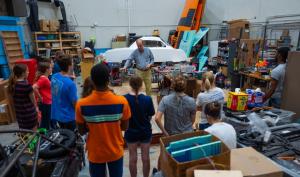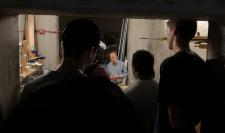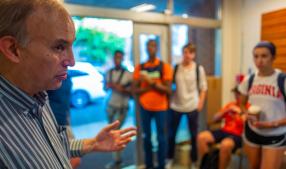
The University of Virginia School of Engineering undergraduates, some highly-charged and others still a little groggy after an early morning jaunt up Observatory Hill, perched around the foyer of the Observatory Mountain Engineering Research Facility passing around faded, color photos of long-past scenes in the Cold War-era building.
The students were from UVA Engineering professor Keith Williams’ Introduction to Engineering class, on a field trip to learn about the glowing-blue pool of irradiated, purified water that once existed here, the nuclear reactor core that sat in the pool, and the consequential role engineers play in developing technology that can help or hurt humanity.
Carved out of the rocky hillside and fortified with concrete seven feet thick, the building housed the third most powerful research reactor in the nation when it was built in 1960, and for 38 years it gave UVA students unique insight into the world of nuclear reactions.
Neutron bombardment in the bowels of the building produced the last watt of energy at the stroke of midnight on July 1, 1998, a dozen years after the Chernobyl Nuclear Power Plant meltdown and following dwindling interest in nuclear engineering research programs around the country.
“This did not power the university. You do not get power from a research reactor,” Paul Benneche told the students gathered around him for the tour. Benneche, who was the supervisor of the reactor when it was operational, has overseen day-to-day operations at the building since the mid-1980s.
Benneche waved them deeper into the decommissioned reactor building. Students filed into a cavernous, circular room, dodging the fiberglass shell of a small, white, solar-powered car propped up on a pair of work carts. The building is now used by student groups that need space to build their projects. Benneche stepped up on a wooden platform built over what was the open pool of water housing the reactor.
“Don't be afraid of being in this building,” he said, but then brought up the fact that many people are. “Radiophobia is a fear of radiation. I’ve met a couple of people that actually had it who literally were terrified of radiation for no particular reason. I think they’ve watched too many ‘Star Trek’ movies.”
In the crowd, Liliana Gomez, a first-year student who is thinking about majoring in computer science, looked up at the high ceiling towering 25 feet above her. “The room made me feel kind of small,” she said.
In her high school physics class, Gomez completed a project about the ramifications of nuclear waste. “While nuclear energy is clean to run, it produces a lot of waste that doesn’t decay for millions of years,” she said. “There are consequences that need to be considered.”


